Napa Cabbage Caesar Salad
If you have ever wondered what to do with Napa Cabbage, wonder no longer. This Napa Cabbage Caesar Salad is the best and most delicious way to use it!
Love Caesar? Make sure to check out our Thick and Creamy Caesar Salad Dressing made with egg. It is just like a restaurant Caesar! And if you prefer it without egg yolk, try our Egg-Free Caesar Salad Dressing too!
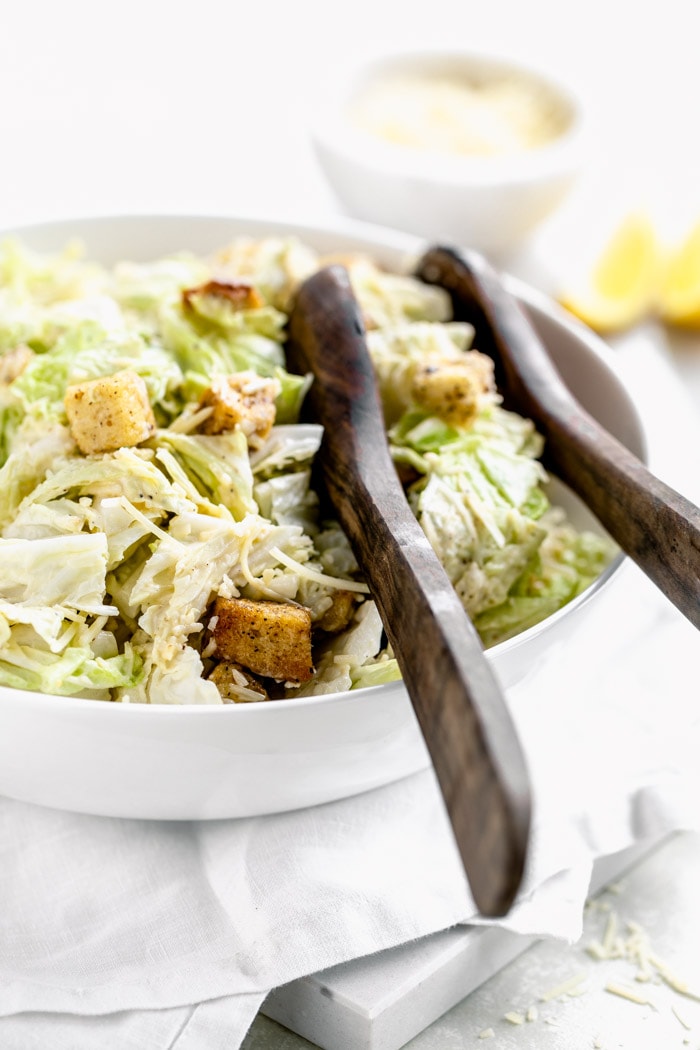
This post contains affiliate links.
Table of contents
When I say “the best” I don’t do so lightly. No offense to my other Napa cabbage recipes, I mean my Cucumber and Napa Cabbage Slaw is legendary, this Easy Holiday Slaw is super popular and this Broiled Steak with Minty Napa Cabbage Slaw is bursting with fresh flavors. But this recipe I have today for Napa Caesar is utterly irresistible. It’s off the charts folks. It makes eating a big bowl of raw cabbage a true delight!
Love Caesar? Make sure to check out our Restaurant Style Classic Caesar Salad with Romaine.
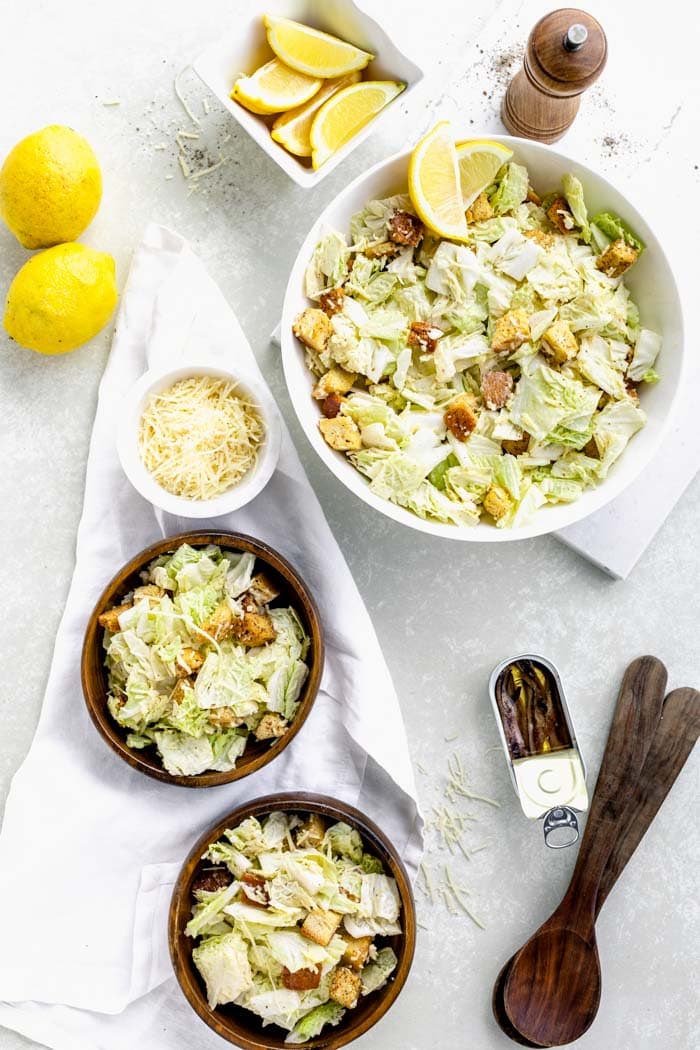
Why Use Napa Cabbage in A Caesar Salad Instead of Romaine
Did you know that buying locally grown veggies can help to reduce your carbon footprint? It is true! That is why here on Healthy Seasonal Recipes I am all about helping you find ways to use locally grown seasonal produce. I love Romaine Caesar just as much as the next person, but in the wintertime Romaine Lettuce, is not available from local farms in most of the country.
Where I live in Vermont, we have a short growing season and harsh winters, so to eat in season means relying on storing crops in the wintertime. Napa cabbage is a great storing crop and can be enjoyed all winter long when kept in cold storage. You can read more about growing cabbage in The Ultimate Guide to Cabbage.
In fact, I bet if you are a member of a winter CSA, you are probably looking for ways to use up some of the Napa cabbage you’ve been getting and maybe that’s how you ended up right here on this recipe!
I fell in love with Napa Caesar Salad when I tried it from a local restaurant. They specialize in Farm to Table cuisine, and I loved their creative use for this storing crop.
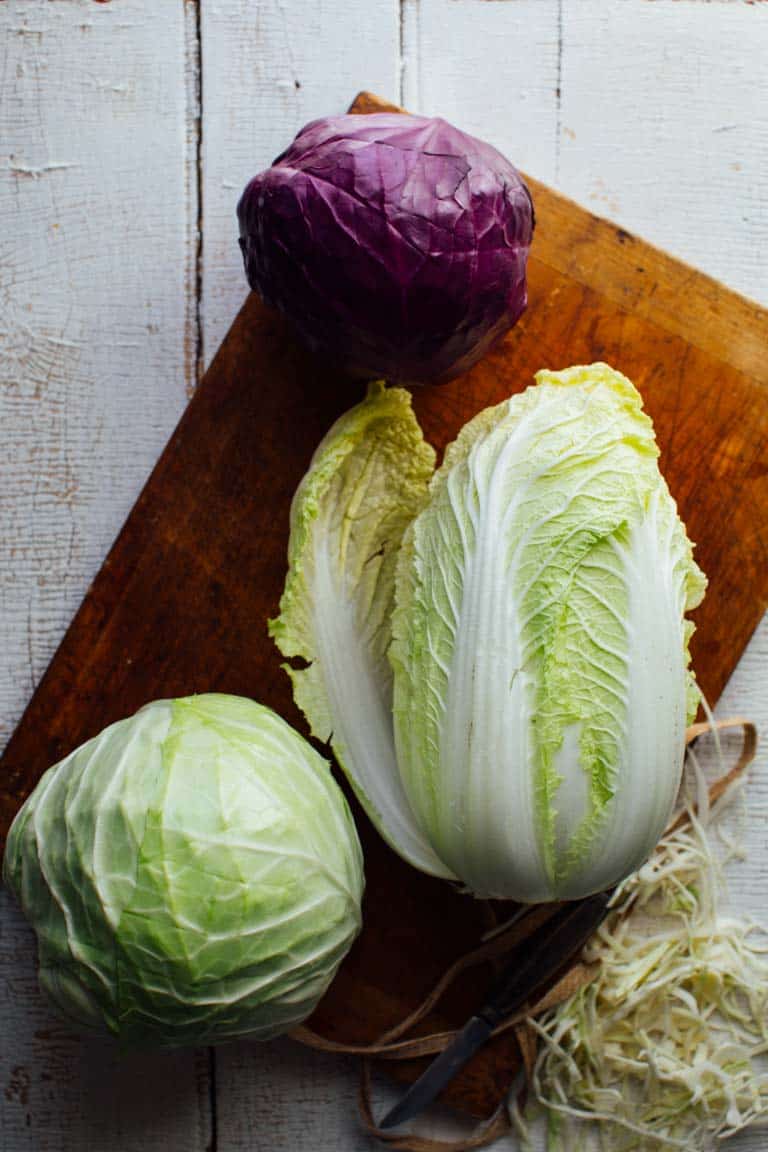
What is the Difference Between Napa Cabbage and Regular Cabbage
Napa Cabbage is a variety of Chinese Cabbage Brassica rapa (variety Pekinensis) whereas regular cabbage is Brassica Oleracea. What that means is that they are both from the Genus Brassica, and they are relatives. But they are different species of cabbages.
- Green and Red heading cabbage (regular cabbage) leaves come together in very dense, tightly formed round heads. Napa Cabbage on the other hand is oval or oblong shaped.
- Napa cabbage has wide flat white ribs that run noticeably up the sides of the head. Green and red cabbage have ribs that are the same color as the leaves and can be tough on outer leaves.
- The texture of napa cabbage is tender and less dense, while regular cabbage is crunchy and more dense.
- Both Chinese Cabbage and Regular cabbage can be eaten raw or cooked, but Napa cabbage breaks down more easily when cooked. Try my Simple Sauteed Napa Cabbage Recipe for perfectly tender, but not limp, cooked Napa!
Ingredients For This Recipe
Anchovies
As with all classic Caesar salad dressings, this one has anchovies in it. If you like to use anchovy paste you can substitute 2 to 3 teaspoons of anchovy paste.
If you don’t like anchovies, you can leave them out, but as I said in my recipe for Puttanesca Sauce, I would urge you to try it with the anchovies because you can’t really taste the fishy taste once they are blended with all of the other strong flavors.
If you do want to omit the anchovies, you can simply add an additional pinch or two of salt to taste to compensate for the lack of sodium. This will help to balance the tartness of the lemon.
Egg yolk
I wanted to use egg yolk in this recipe because I wanted an ultra creamy Caesar dressing.
Egg yolk has a naturally occurring emulsifier called lecithin in it, which helps the oil and liquid in this recipe bind together into a thick and creamy emulsion. The texture will be like a thin aioli or mayonnaise.
If you prefer to not use raw egg, you can follow the instructions for How to Make Egg Free Caesar Dressing here.
Garlic
I call for one clove of garlic in the dressing. It had plenty of garlic for me. If you love raw garlic, you could add a second clove, but I find that a little goes a long way with raw garlic.
If you love garlic, and you love Caesar salad, then you should definitely check out my Roasted Garlic Caesar Salad which is served with a whole head of garlic per person as an accompaniment!
Lemon juice
Fresh lemon juice gives this dressing its tart taste. I recommend squeezing your own for the best flavor.
Dijon mustard
Dijon mustard is a classic addition for Caesar salad dressings. It adds spicy flavor and also helps the dressing form an emulsion.
Worcestershire sauce
I have several Caesar Salad recipes here on Healthy Seasonal Recipes, and this is my only one with the addition of Worcestershire. It adds another level of salty, sour and umami flavor to the dressing.
Avocado Oil and Olive Oil
I like to use a blend of oil for this dressing. The olive oil on its own is too fruity and can taste bitter. So I cut it with a neutral cooking oil. My preferred neutral oil is avocado, but if you prefer another neutral oil or vegetable oil, that is fine to use.
Napa cabbage
The star of this recipe is the Napa Cabbage. You will need 10 cups of chopped cabbage.
Croutons
I love making homemade croutons, but on a busy weeknight, I am not always inclined to take the time to make them from scratch. You can purchase them, and feel free to use gluten-free croutons.
Parmesan cheese
I used grated Parmigiano Reggiano cheese which blends into the Caesar really nicely and gives it an overall cheesy taste.
If you like another hard Italian cheese, you can substitute it instead, just make sure to skip the added salt until you taste the tossed salad. Pecorino and Asiago are both very salty compared to Parm, so you may want to skip the added salt.
Salt
If this is your first time making this recipe, toss the salad together before seasoning it. You may not feel like it needs it. I found that 1/4 teaspoon was just right for my palate.
Freshly ground pepper
I love to use a heavy hand with fresh pepper when I make Caesar. Add it to taste at the end.
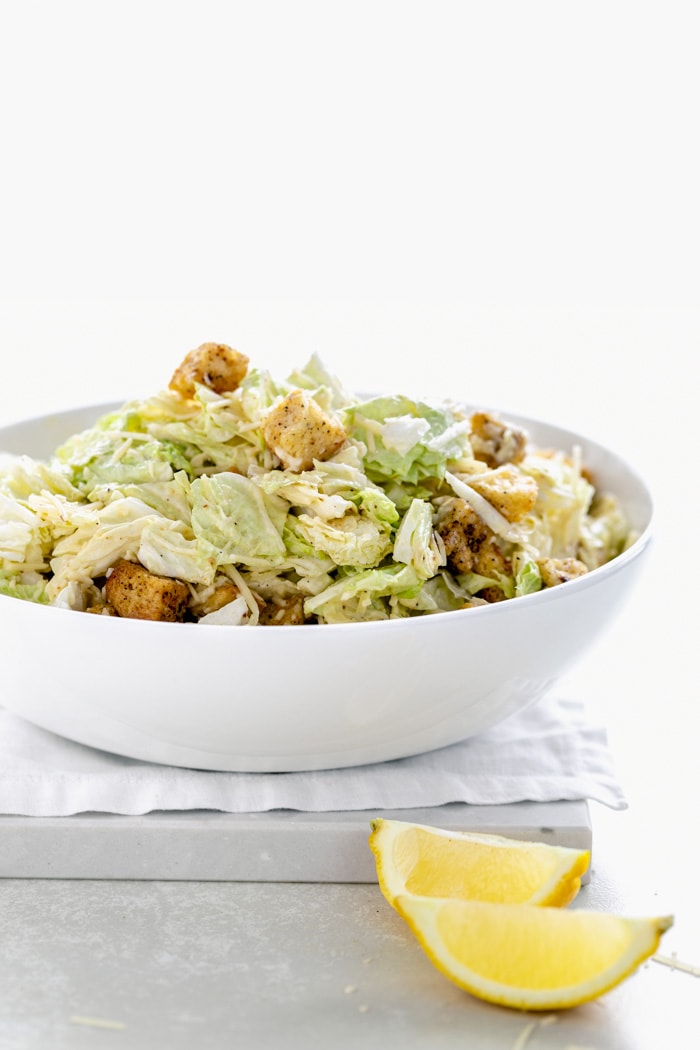
How To Make Caesar Salad with Napa Cabbage
Cut The Cabbage
The key to making the Napa stand in for Romaine is in how you cut it. The flat leafy and green top half of the cabbage is best for this recipe. Save the bottom half to add to your Pad Thai or Coconut Chicken Soup.
- Cut the head in half lengthwise through the core.
- Lay the cabbage half, cut side down on the cutting board. Cut through the half, crosswise to separate the top of the head from the bottom half.
- The green leafy top half is best for this recipe. Reserve the bottom half with a larger proportion of the crisp white ribs for another use.
- Cut the Napa into small bite size squares.
Of course if you have a smaller head of Napa and need to use more than half of it to make-up 10 cups for this recipe, you can certainly use the part with the white ribs. Read more on how to cut cabbage here.
Make The Dressing
I tried making this dressing by hand with a whisk. It was tricky to get the emulsion to hold. So I then tried it with my immersion blender and it was 10 times better! It was thick and creamy and just want I envisioned.
Use a Blender For Creamy Dressing
If you don’t have an immersion blender, you can also use a blender or mini prep to blend it. You will have to drizzle the oil into the lemon and yolk mixture to create the emulsion. The point is that the creamy texture will be so much better when blended with a motor than by hand.
Whisk By Hand
Of course if you don’t own one of these small appliances, you can mix by hand with a whisk. You’ll want to whisk the dressing ingredients in a bowl first. Then add the oil very slowly while constantly whisking to form the emulsion.
Make The Salad
Combine the Napa Cabbage, Croutons and Parmesan in a large salad bowl. Tip: Make sure you choose a bowl that is big enough to toss the salad without it spilling out as you toss.
Drizzle on the dressing. Toss the salad to combine and coat the cabbage and croutons with the dressing and Parmesan.
Taste the salad and add the salt and pepper to your taste preference.
Step By Step Photos For This Recipe
- 1. Cut the cabbage in half lengthwise.
- 2. Cut the top half of the cabbage off, and cut into strips about 1 1/2 inch wide.
- 3. Cut strips in to 1-inch pieces
- 4. Combine the dressing ingredients in the blender or blending jar if using immersion blender.
- 5. Puree until thick and creamy
- 6. Combine the Napa Cabbage, Croutons and Parmesan in a bowl. Drizzle on dressing and toss to coat.
Make Ahead Instructions
- To make this salad ahead, cut the cabbage as directed above. Add it to the salad bowl. Lay a wet paper towel or kitchen over it. Cover in plastic wrap and refrigerate up to 2 days. You can also chop the Napa and put it in a resealable plastic bag and refrigerate it for 2 days.
- The dressing can be made 1 to 2 days ahead. It will be quite thick after you refrigerate it, so let it sit out at room temperature for 30 minutes before tossing it with the salad.
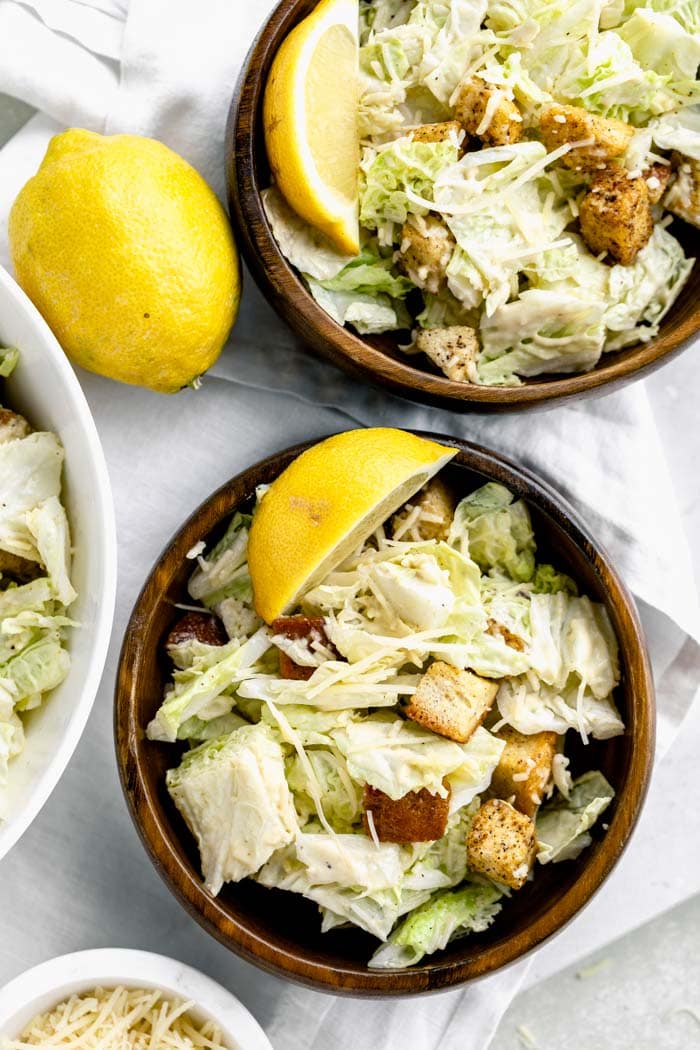
More Caesar Salad Recipes and Cabbage Recipes
This Overnight Kale Caesar Salad is another non-traditional Caesar to try. Letting the tossed kale sit in the fridge overnight tenderizes it a bit.
Meal Prep Wasabi Glazed Salmon Power Salads are made on a bed of Napa Cabbage, which holds up well for meal prep.
You can use Napa Cabbage instead of Romaine in this recipe for Thai Style Fish Cakes with Herbal Salad.
I love adding Cabbage to soups like this Slow Cooker Kielbasa, Cabbage and Potato Soup or Ukrainian Borscht.
Thanks so much for reading. If you make this recipe, please come back and leave a star rating and review!
Happy Cooking!
~Katie
Print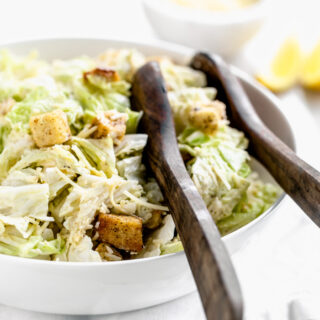
Napa Cabbage Caesar Salad
- Total Time: 15 minutes
- Yield: 14 cups 1x
Description
If you are wondering what to do with a head of Napa Cabbage, then try this Napa Cabbage Caesar Salad. It is the best most delicious way to cook with it!
Ingredients
6 anchovy fillets, chopped or 2 teaspoons anchovy paste
1 egg yolk
1 clove garlic, minced
3 tablespoons lemon juice
2 teaspoons Dijon mustard
3 to 5 dashes Worcestershire sauce
1/2 cup avocado oil or organic canola oil
1/4 cup olive oil
10 cups chopped Napa cabbage
2 cups croutons, homemade or purchased (5 oz)
3/4 cup shredded Parmesan cheese
1/4 teaspoon salt, or to taste
Freshly ground pepper, to taste
Lemon wedges and additional Parmesan cheese for serving
Instructions
- Combine anchovies, egg yolk, garlic, lemon, Dijon and Worcestershire in a blending jar, blender or mini prep. Puree to combine. For immersion blender add avocado oil and olive oil and puree until thick and completely combined. For blender, mini prep or whisk, gradually add the oil in a thin stream through the feed tube.
- Combine Napa, croutons and Parmesan cheese in a large salad bowl. Add the dressing and toss until the cabbage and croutons are evenly coated in the dressing. Taste and season with salt and pepper and toss again. Serve with lemon wedges and additional Parmesan.
Notes
Make Ahead Instructions
- To make this salad ahead, cut the cabbage as directed above. Add it to the salad bowl. Lay a wet paper towel or kitchen over it. Cover in plastic wrap and refrigerate up to 2 days. You can also chop the Napa and put it in a resealable plastic bag and refrigerate it for 2 days.
- The dressing can be made 1 to 2 days ahead. It will be quite thick after you refrigerate it, so let it sit out at room temperature for 30 minutes before tossing it with the salad.
- Prep Time: 15 minutes
- Cook Time: 0 minutes
- Category: Salad
- Method: No cook
- Cuisine: American
Nutrition
- Serving Size: 2 cups
- Calories: 383 Calories
- Sugar: 0 g
- Fat: 31 g
- Saturated Fat: 4 g
- Carbohydrates: 20 g
- Fiber: 0 g
- Protein: 8 g

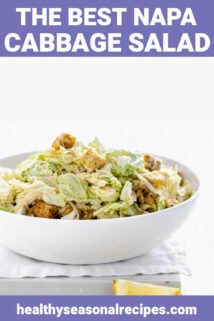
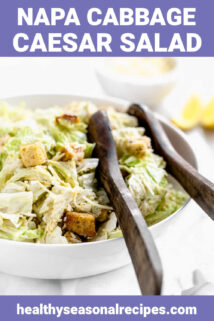
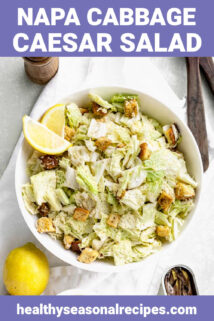
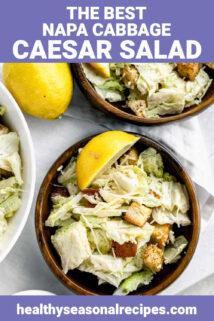
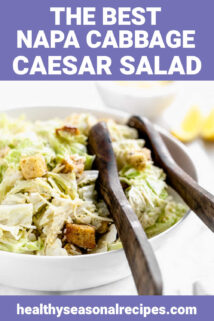
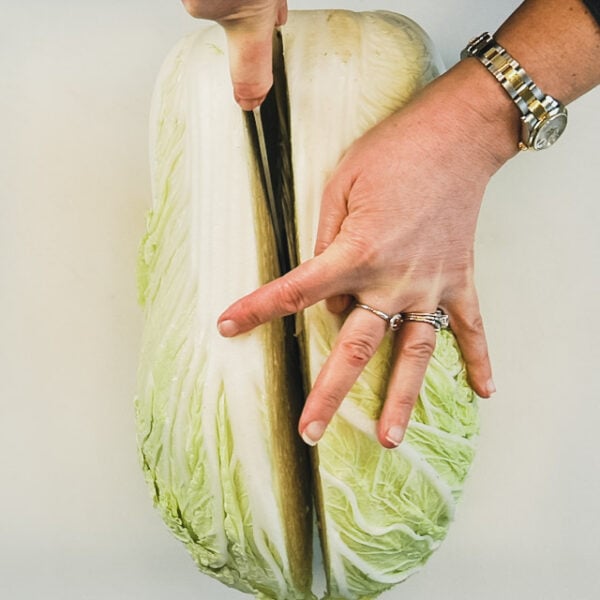
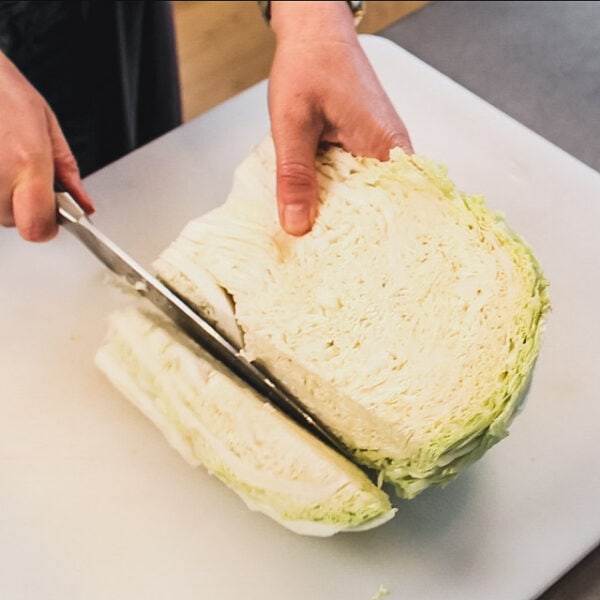
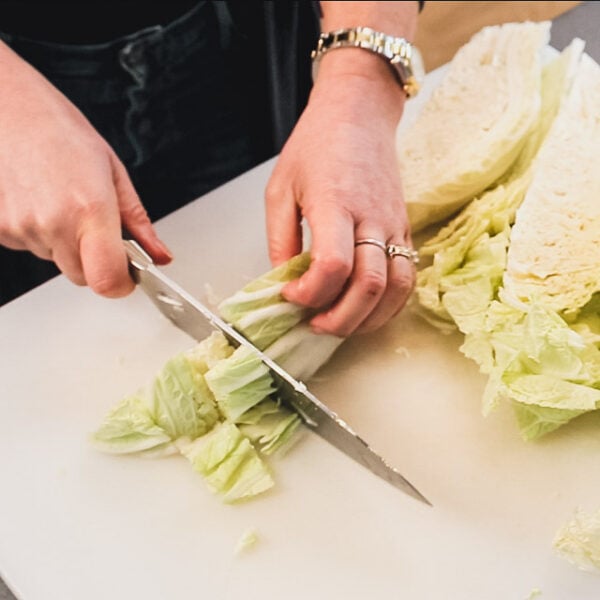
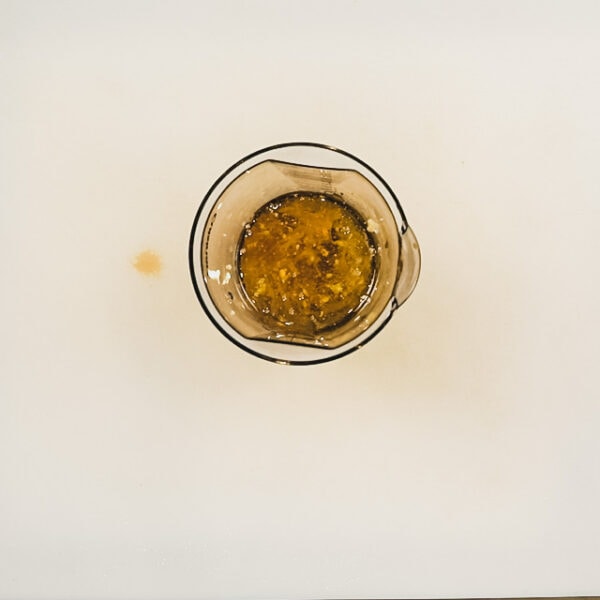
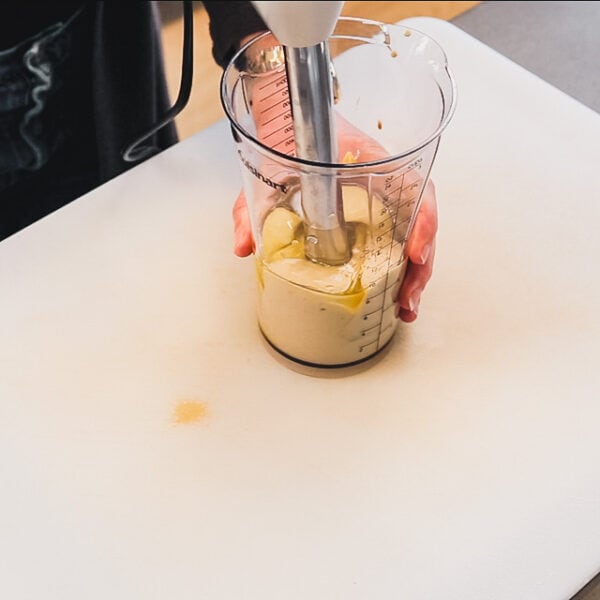
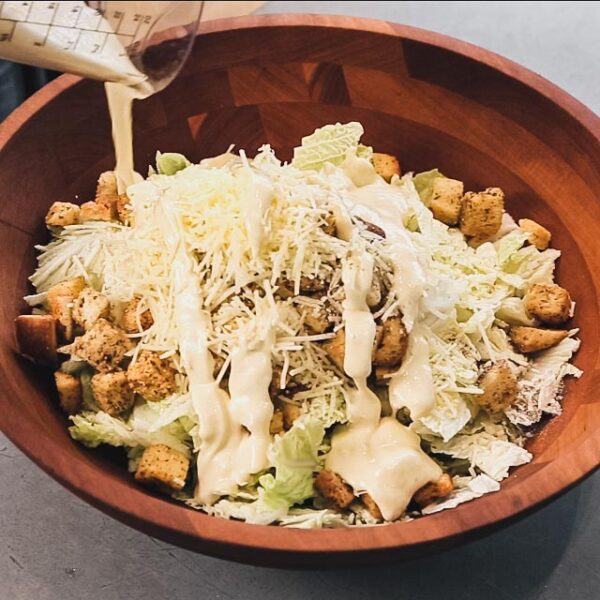



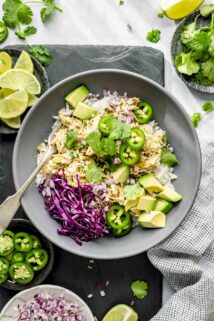
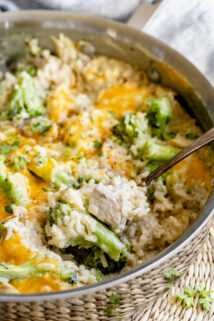


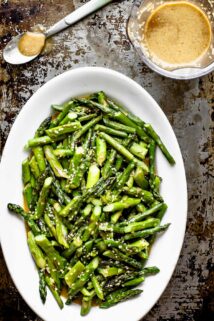
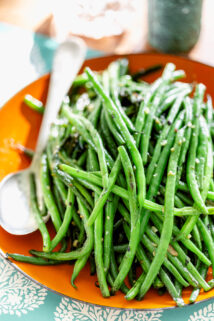

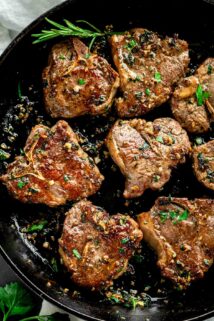
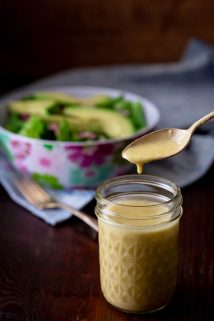

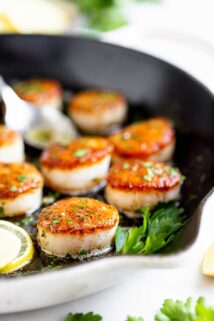
Our family loved this!!!
This salad was so delicious. And I totally agree about using the anchovies, I don’t each anchovies normally but in this dressing they really the salad sing.
Love that! Yay! Thanks Shannon. So glad you liked it.
I love the idea of using cabbage instead of romaine for a caesar salad. Yum!
It really works!
I am a big cabbage fan (Austrian after all) so this is going to be my new favorite way to enjoy Napa Cabbage. What a fun idea! Loved it!
I am so happy to hear it!
good thing this recipe makes a lot of salad. I can’t stop eating this. Delicious!
Yay! I am so glad you like it. Thanks for letting me know.